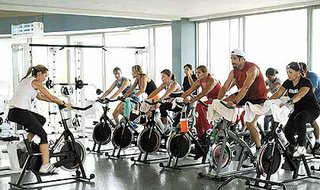Friday, July 28, 2006
Tuesday, July 25, 2006
Patience
Sorry I have written about this topic twice now. It must be the season God is taking me through at this time in my life. I am LOVING the 'Living Beyond Yourself' Beth Moore study I am doing with my small group! This study is taking us through the Fruit of the Spirit and right now we are reviewing 'patience'.
Did you know there are two types of patience:
Patience in CIRCUMSTANCE is inspired by HOPE
Patience in PEOPLE is inspired by MERCY
The Bible is full of 'patience'. Job for example used the 'circumstance' patience through his difficulties. Most other scriptures refer to the PEOPLE kind of patience - because God always puts people first.
We should do this as well - PEOPLE before CIRCUMSTANCE. I can't say I always do this. I pray God would change me in my patience and give me LOTS of HOPE AND MERCY!
Thoughts anyone?
Did you know there are two types of patience:
Patience in CIRCUMSTANCE is inspired by HOPE
Patience in PEOPLE is inspired by MERCY
The Bible is full of 'patience'. Job for example used the 'circumstance' patience through his difficulties. Most other scriptures refer to the PEOPLE kind of patience - because God always puts people first.
We should do this as well - PEOPLE before CIRCUMSTANCE. I can't say I always do this. I pray God would change me in my patience and give me LOTS of HOPE AND MERCY!
Thoughts anyone?
Thursday, July 20, 2006
Spinning...out of control!
 I had my first experience with a spinning class today! Oh boy! People that know me are probably already laughing, and I don't blame them. I am not exactly the most physically fit person in the world, but hey, at least I'm trying.
I had my first experience with a spinning class today! Oh boy! People that know me are probably already laughing, and I don't blame them. I am not exactly the most physically fit person in the world, but hey, at least I'm trying.My friend Lora goes every week and I sort of invited myself. It started at 5:15 (yes AM) and went until 6am. 45 minutes of extreme torture!
I almost fell off numerous times due to my lack of coordination! Also, I don't like to look in the mirror anyway, and then watching myself die in the mirror is even worse! Not to mention the skinny mini's in the class barely breaking a sweat and looking like they are out for beauty queen of the spinning class. So, after all that, I have decided I will keep going. Why? Because I have to do something physical, and if it is only weekly, I can handle that.
Once it was over and I pried my butt off the bike, I felt as if I was floating across the floor like a hover craft! Now hours later I am experiencing sore muscles in my legs and in the saddle area! Stairs and hills are a no no!
I invite anyone who lives near me, if you are in need of a good laugh, come spinning with me next Thursday AM!
In case you want to learn some, here is a little bit about spinning:
Indoor cycling
From Wikipedia, the free encyclopedia
(Redirected from Spinning (cycling))
Indoor cycling is a form of exercise that involves using a stationary exercise bicycle in a classroom setting. The concept was created in the 1980s by ultra-endurance athlete Jonathan Goldberg ("Johnny G."). Participants set goals based on their heart rate.
A typical class involves a single instructor at the front of the class who leads the participants in a number of different types of cycling. The routines are designed to simulate terrain and situations encountered in actual bicycle rides, including hill climbs, sprints and interval training. Coasting downhill, however, is not simulated. The instructor uses music and enthusiastic coaching to motivate the students to work harder.
Each person in the class can choose his/her own goals for the session. Some participants choose to maintain a moderate, aerobic intensity level, while others drive their heart rates higher in intervals of anaerobic activity. It can be difficult to stay at the moderate level in a class that is geared towards more intensity. If the exercise is not done correctly, injuries can occur; problems with the lower back and knees are most common.
Classes generally use specialized stationary bicycles. Features include a mechanical device to modify the difficulty of pedalling, specially-shaped handlebars, and multiple adjustment points to fit the bicycle to a range of riders. The pedals are equipped with toe straps to hold the foot to the pedal, enabling powerful upstrokes. They may also have cleats for use with specialty bicycling shoes. These bicycles do not have the electronic features found on some models of stationary bicycles.
The difficulty of the workout is modulated in three ways:
by varying the resistance on a flywheel attached to the pedals. The resistance is controlled by a knob, wheel or lever that the rider operates, causing the flywheel brake (a common bicycle brake, a friction wheel, a magnetic eddy-current brake, a viscoelastic fluid brake, or a strap running around the flywheel) to tighten. Tightening the brake makes pedalling more difficult while loosening it makes pedalling easier. On most bikes, the brake can be completely loosened, leaving no resistance to pedalling except the inertia of the flywheel; or it can be tightened to a point that the rider can no longer generate enough force to turn the flywheel. Usually, riders who can not tolerate the resistances called out by the instructor are encouraged to ride at a level at which they feel comfortable yet challenged.
by changing the cadence (the speed at which the pedals turn). Pedalling faster against high resistance expends more energy than pedalling slowly against low resistance.
by sitting or standing in various positions:
forward; hands at the frontmost part of the handlebars where the handles are parallel to the sides of the rider's body, used only when out of the saddle
middle; hands on the 12-14" part of the handlebars that crosses the rider's body
rear; hands at the center part of the handlebars
any mode of "hovering" where any muscles are isolated and the natural movement of another body part is forced to cease is not an approved or safe method for Spinning and is not part of the official Spinning program.
Each of these positions works the muscles in slightly different ways. Proper form for standing while pedalling requires the body to be more upright and the back of the legs touching or enveloping the point of the saddle, with the center of gravity directly over the crank. The center of gravity or pressure of body weight should never rest on the handlebars.
Most indoor cycling classes is coached to music. Riders may synchronize their pedalling to be in time with the rhythm of the music, thus providing an external stimulus to encourage a certain tempo. Often, the music chosen by the instructor is dance music or rock music set to a dance beat (i.e. 4/4 time), but not necessarily. This tends to help motivate participants to work harder than they might otherwise. While the music provides a tempo cue, the cadence does not need to be a multiple of the beat in order for the rider to feel in rhythm; the music therefore helps a rider maintain any constant cadence, not just a cadence that matches the beat.
It is recommended when riding in a class to bring plenty of water. Indoor cycling is very energetic and causes a lot of sweating, and a person who is near dehydration can easily be dehydrated by the end of an hour of hard riding. One ounce (29.57 millilitres) of water consumed for each minute of work is the recommended and safest hydration ratio.
The flywheel resistance control is also used to brake the flywheel. When changing from fast pedaling to slow, the flywheel brake may be used to slow the flywheel rather than allowing the force of the angular momentum to be applied to ones knees and legs.
Thursday, July 13, 2006
Patience
I have the privledge to doing a Beth Moore Study right now called Living Beyond Yourself. The daily study I just did talks about patience and how scriptually it is the opposite of judgement. What do you think about this?


